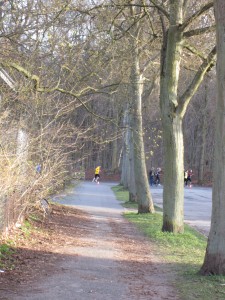
Spring is the ideal season for outdoor sports in Denmark.
Spring has finally arrived to Denmark at full sail; green buds are waiting everywhere to shoot from the trees and hedges. There is no turning back… Let’s take a break from spellings and tongue twisters, and look at the Danish årstider (seasons, literally ”times of the year”)…
Forår is pronounced ”FORE-ore” in the British way (Americans, drop that r!) The name of the year’s first season literally – and quite fittingly! – means ”fore-year”. It starts in marts, sometimes in februar or april or not at all. The Danish vejrguder (”weather gods”) are very impulsive, so you never know… It is now people start buying ice-cream, holding hands on the beach, and doing outdoor sports.
Sommer is – summer. (Somre in the plural.) If it isn’t already there in maj, you’re sure to meet it in juni – though, of course, it may all rain away… With a bit of luck, temperatures will rise to 20-something, and after a swim and a pint of øl you just might consider spending your sommerferie (summer holiday) at the local strand (beach) instead of going abroad.
Sometimes the Danish summer extends into September, in which case it is called indian summer (yeah, we haven’t bothered to make a Danish translation for that one…)
Efterår is pronounced ”EFT-ore-ore” and means ”after-year”. While this sounds a bit sad (think ”afterlife”!), efterår is really the beginning of everyday life in Denmark; people get back from their holidays, and new students start at the schools and universities. The Danish countryside can get quite pretty in autumn/fall, with all the leaves turning gule, røde and orange (you get the colours – mind the plurals!) At the end of november, though, ”all the leaves are brown”, and people are seeking hygge in front of their tv sets as they get ready for the cold
Vinter. The Vikings used to tell their age in vintre, as in ”I killed my first man when I was 15 winters old”. I’m sure a lot of people would feel rejuvenated if we still counted like that! A winter without sne (snow) is by no means a rarity anymore, and I’ve often heard people sighing that it’s all one laaarge efterår…
But nevermind, who thinks about that while foråret (the Spring) is here!






Comments:
Alex:
What do the |s mean in the words?
Is that to represent stød or something?
I really don’t know.
Bjørn A. Bojesen:
@Alex
The |s are just a way to show the plural: hat|s.
I don’t want to confuse my readers! (In fact, quite the opposite! 🙂 )
I’ll remove the |s from this post.
Do you have any idea how I could show plural endings in a clearer way?
Alex:
Hi Bjorn,
Oh okay, that makes sense if they were used for plurals, I wasn’t sure. In other languages I usually see it with a slash. But, I would understand it if there was a little note at the top saying (the plural form is found after the |), just because it’s something I think people will be familiar with.
Tak for endnu et godt indlæg.
Bjørn A. Bojesen:
Yes, I’ve seen those slashes, and never really liked them as ”plural separators”… They’re already in web addresses and fractions (1/4), besides being used to mean ”and/or”.
But I’ll try to put my personal preferences aside, and stick to the / people know in future posts… 🙂
Selv tak! Der er flere på vej…